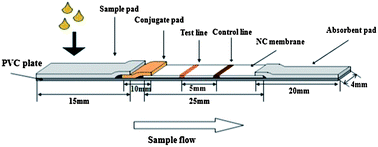A gold nanoparticle-based immunochromatographic assay: The influence of nanoparticulate size
Abstract
Four different sized

- This article is part of the themed collection: 2012's Top 25 most read Analyst articles
* Corresponding authors
a
Key Laboratory of Magnetic Materials and Devices and Division of Functional Materials and Nanodevices, Ningbo Institute of Materials Technology & Engineering (NIMTE), Chinese Academy of Sciences, Ningbo, China
E-mail:
aiguo@nimte.ac.cn
Tel: +86-574-86685039
b Ningbo Dingxin Biological Sci. & Tech. Co. Ltd, Ningbo, China
c
Ningbo No.2 Hospital, Ningbo, China
E-mail:
chasejxmc@163.com
Four different sized

 Please wait while we load your content...
Something went wrong. Try again?
Please wait while we load your content...
Something went wrong. Try again?
S. Lou, J. Ye, K. Li and A. Wu, Analyst, 2012, 137, 1174 DOI: 10.1039/C2AN15844B
To request permission to reproduce material from this article, please go to the Copyright Clearance Center request page.
If you are an author contributing to an RSC publication, you do not need to request permission provided correct acknowledgement is given.
If you are the author of this article, you do not need to request permission to reproduce figures and diagrams provided correct acknowledgement is given. If you want to reproduce the whole article in a third-party publication (excluding your thesis/dissertation for which permission is not required) please go to the Copyright Clearance Center request page.
Read more about how to correctly acknowledge RSC content.
 Fetching data from CrossRef.
Fetching data from CrossRef.
This may take some time to load.
Loading related content
